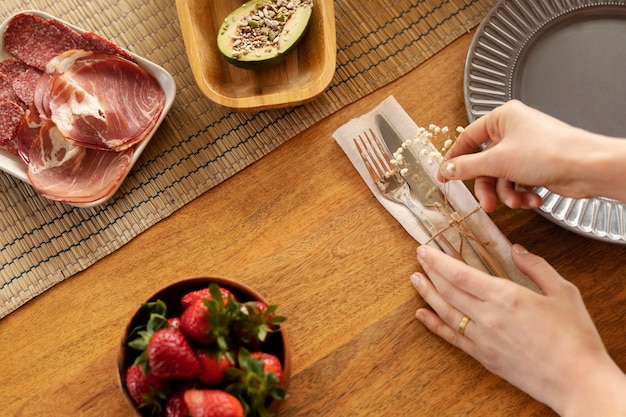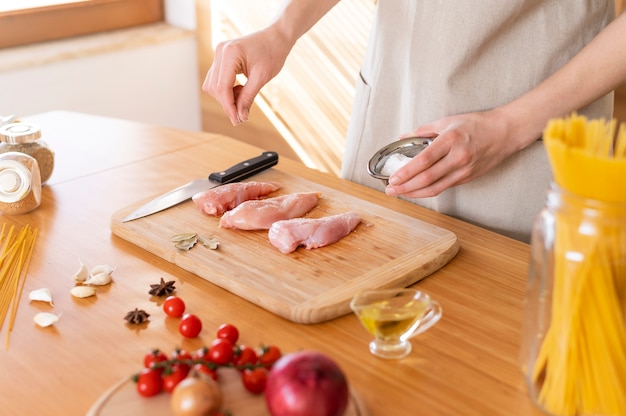(Part 1) Choosing Your Weapon: The Right Ham

1. The Classics: Bone-In vs. Boneless
Ah, the bone-in vs. boneless debate! It's a classic, and for good reason. bone-in hams, those with the bone still intact, are the traditional champions. They've been cured for longer, resulting in a more intense, deeply savoury flavour. The downside? They're a bit more tricky to carve, requiring a bit more finesse (and maybe a YouTube tutorial). boneless hams, on the other hand, are the convenience warriors. Easier to handle, easier to carve, they're the go-to choice for the time-pressed. But they often lack the depth of flavour that bone-in hams offer. Ultimately, the choice is yours, my friend. Which warrior will you choose?2. The Curing Game: Cured vs. Uncured
Now, let's talk about the curing process. cured hams have been bathed in salt and nitrates, and often pre-cooked, making them a shortcut to deliciousness. They're generally salty, with a distinctive, somewhat tangy flavour. uncured hams, the naturally seasoned contenders, are the blank canvas of the ham world. They require cooking from scratch, giving you control over the seasoning and allowing you to create your own flavour profile.3. The Smoke Effect: Smoked vs. Unsmoked
Last but not least, we have the smoky factor. smoked hams are the masters of the smoky aroma. They have a distinct, wood-fired flavour that some adore, while others prefer the more subtle taste of unsmoked hams. It's a matter of personal preference, so choose the ham that calls to your taste buds. Keep in mind that smoked hams are often pre-cooked, meaning you'll mainly be reheating them.(Part 2) Gettin' Ready: Prepping Your Ham

1. The Big Unwrap: Removing Packaging
First, we must banish the packaging. Remove the plastic wrap and any netting that might be holding your ham captive. I always give it a good rinse under cold water just to make sure it's clean and free of any loose bits.2. A Little TLC: Scoring the Ham
Next, we're going to give our ham a little TLC. Scoring the ham is key – it allows the heat to penetrate evenly and the glaze to sink in deeper, resulting in a more flavorful and evenly cooked ham. With a sharp knife, make shallow, diamond-shaped cuts about a half-inch deep. But be careful, don't go all the way through!3. The Flavor Boost: Seasoning the Ham
Now for the fun part! Seasoning your ham is where your creativity shines. I'm a fan of a simple mix of brown sugar, mustard, and cloves. It adds a sweet and tangy depth to the ham's natural flavour. But feel free to unleash your inner chef – pepper, garlic powder, herbs, even a touch of chili powder – the possibilities are endless. Rub the seasoning all over the ham, making sure to get into those scored grooves.(Part 3) The Oven's Calling: Cooking Your Ham

1. Temperature Check: Oven Settings
Preheat your oven to 325 degrees Fahrenheit (160 degrees Celsius). We're going for low and slow, my friend. This gentle heat allows the ham to cook evenly without drying out.2. The Right Dish: Cooking Vessel
I usually cook my ham in a roasting pan, but you can also use a dutch oven or a large baking dish. Just make sure it's spacious enough to accommodate your ham comfortably. If the ham came in oven-safe packaging, you can cook it in that too.3. The cooking time: How Long to Cook
Here's where the real strategizing comes in. The cooking time for a 11-pound ham depends on a few factors – whether it's bone-in or boneless, cured or uncured. But fear not, I've compiled a handy table for your reference:| Ham Type | Cooking Time (Approx.) |
|---|---|
| Bone-in, Cured | 15-20 minutes per pound |
| Boneless, Cured | 10-15 minutes per pound |
| Bone-in, Uncured | 20-25 minutes per pound |
| Boneless, Uncured | 15-20 minutes per pound |
(Part 4) The Glaze Factor: Sweetening the Deal
While your ham is busy cooking, you can start crafting your secret weapon – the glaze. This is where you add that final touch of sweetness and shine.1. Ingredients You Need
Here's a simple glaze recipe that always delivers:- 1/2 cup brown sugar
- 1/4 cup honey
- 2 tablespoons Dijon mustard
- 1 tablespoon apple cider vinegar
- 1/2 teaspoon ground ginger
- 1/4 teaspoon ground cinnamon
2. The Glaze Process
Combine all the ingredients in a saucepan over medium heat. Stir constantly as it simmers until the sugar dissolves. You want a smooth, thick glaze that will coat your ham beautifully.3. The Glaze Application
After your ham has been cooking for about an hour, it's time to unleash the glaze. Baste your ham generously with the glaze every 30 minutes for the last hour of cooking. This will give it a beautiful sheen and add a layer of delicious sweetness.(Part 5) The Rest and Relaxation: Letting the Ham Chill
The ham has fought its battle bravely, and now it deserves a moment of peace. Allowing the ham to rest is essential for ensuring juicy, tender results. Let it rest for at least 15 minutes before carving. This gives the juices time to redistribute throughout the meat, leading to a more flavorful experience.(Part 6) The Carving Ceremony: Breaking It Down
The moment has arrived – it's time to unveil your culinary masterpiece! Carving a ham can seem intimidating, but I assure you, it's not as hard as it looks. Let's tackle this together.1. The First Slice: Separating the Shank
If you're working with a bone-in ham, start by slicing down the side of the ham, carefully separating the shank from the main portion. You can carve the shank into slices or remove the bone entirely and serve it whole.2. The Main Event: Carving the Ham
Now, for the main act. Cut slices about 1/2 inch thick, making sure to follow the grain of the meat. This will ensure the slices are tender and easy to eat. For boneless hams, you can simply carve it into slices or cut it into cubes for a more rustic presentation.3. Presentation Matters: Arranging the Ham
With your ham carved to perfection, it's time to dress it up for its grand debut. Arrange it on a platter, showcasing your culinary prowess. I like to pair my ham with roasted vegetables, creamy mashed potatoes, and a tangy cranberry sauce. Add some fresh herbs and fruit slices for a pop of colour and freshness.(Part 7) Ham Heaven: Serving and Storing
You've cooked it, carved it, and now it's time to enjoy your masterpiece! Let's discuss how to serve and store your ham.1. Serving Suggestions
The beauty of ham is its versatility. It can be served warm, cold, or at room temperature. Pair it with your favourite sides, or use it to create delightful sandwiches, salads, or even a hearty quiche.2. Storing Leftovers
If you have leftover ham (which is highly unlikely!), store it in the refrigerator for up to 4 days. Wrap it tightly in plastic wrap or aluminum foil to prevent it from drying out. For longer storage, freeze your leftover ham for up to 2 months. Wrap it tightly in freezer paper or plastic wrap.3. Reheating Leftovers
When you're ready to enjoy those leftovers, you can reheat them in the oven, microwave, or on the stovetop. I prefer the oven method – heat it at 325 degrees Fahrenheit for about 15-20 minutes.(Part 8) The Ham Commandments: Top Tips
Here are a few final tips to ensure your ham-cooking adventure is a success:- Don't be afraid to experiment with different glazes and seasonings. Get creative and let your taste buds be your guide!
- For extra moisture, add a cup of water or apple cider to the bottom of the roasting pan.
- When cooking a bone-in ham, be sure to check the internal temperature of the thickest part of the meat, avoiding the bone.
- Remember to let your ham rest for at least 15 minutes before carving.
- Most importantly, enjoy your ham! It's a delicious and festive meal that's sure to impress.
FAQs
Here are a few commonly asked questions about cooking ham:
1. Can I cook my ham in a slow cooker?
Absolutely! Place your ham in the slow cooker and cook it on low for 6-8 hours. Add some water or apple cider to keep it moist.2. Can I cook my ham in a pressure cooker?
You can! However, it will cook much faster. Consult your pressure cooker manual for specific instructions.3. What can I do with leftover ham?
Leftover ham is a culinary gold mine! Use it in sandwiches, salads, soups, or even quiche.4. What are some good side dishes to serve with ham?
Mashed potatoes, roasted vegetables, cranberry sauce, and green beans are classic companions to a delicious ham.5. How long can I keep cooked ham in the refrigerator?
You can keep cooked ham in the refrigerator for up to 4 days. Make sure to wrap it tightly to preserve its moisture.And there you have it, my friend! A complete guide to conquering the 11-pound ham. So go forth, armed with this knowledge, and create a culinary masterpiece that will be the talk of the town. Remember, the most important ingredient is a touch of confidence and a whole lot of fun!
Everyone is watching

Corn on the Cob: The Ultimate Guide to Perfectly Cooked Ears
Healthy MealsAh, corn on the cob. Just the name evokes images of sunny days, barbecues, and that sweet, juicy flavour that ...

Scallops: The Ultimate Guide to Perfect Cooking
Healthy MealsAh, scallops. Those delicate, sweet, and utterly delicious morsels of the sea. They hold a special place in my...

Spaghetti Squash: The Ultimate Guide to Cooking and Serving
Healthy MealsRemember that time you saw spaghetti squash at the supermarket, looking all bumpy and strange, and thought, "W...

Salmon Cooking Times: Perfect Guide for Every Recipe
Healthy MealsLet me tell you, cooking salmon is an art form. It's all about getting that perfect balance: juicy and tender,...

Ham Cooking Time: How Long to Bake, Smoke, or Boil a Delicious Ham
Healthy MealsAh, ham. It's a classic, isn't it? A real crowd-pleaser, especially around holidays. And when done right, it'...
